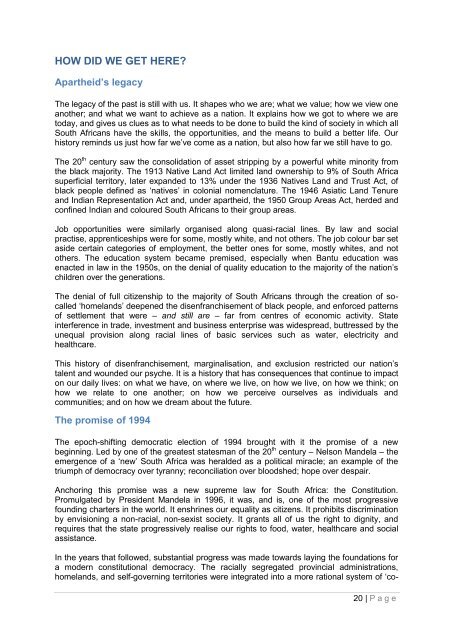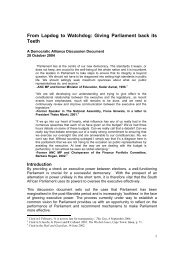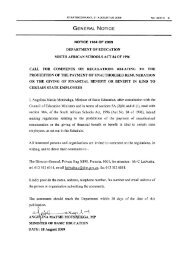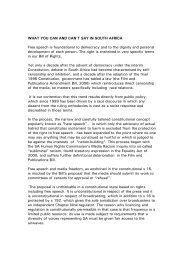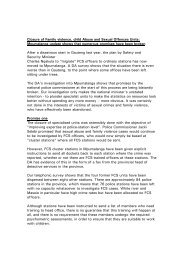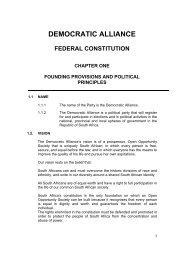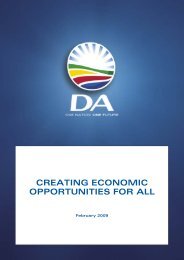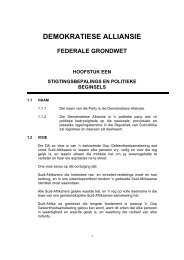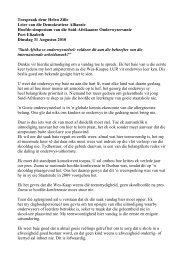DA's Plan for Growth and Jobs - Democratic Alliance
DA's Plan for Growth and Jobs - Democratic Alliance
DA's Plan for Growth and Jobs - Democratic Alliance
You also want an ePaper? Increase the reach of your titles
YUMPU automatically turns print PDFs into web optimized ePapers that Google loves.
HOW DID WE GET HERE?Apartheid’s legacyThe legacy of the past is still with us. It shapes who we are; what we value; how we view oneanother; <strong>and</strong> what we want to achieve as a nation. It explains how we got to where we aretoday, <strong>and</strong> gives us clues as to what needs to be done to build the kind of society in which allSouth Africans have the skills, the opportunities, <strong>and</strong> the means to build a better life. Ourhistory reminds us just how far we’ve come as a nation, but also how far we still have to go.The 20 th century saw the consolidation of asset stripping by a powerful white minority fromthe black majority. The 1913 Native L<strong>and</strong> Act limited l<strong>and</strong> ownership to 9% of South Africasuperficial territory, later exp<strong>and</strong>ed to 13% under the 1936 Natives L<strong>and</strong> <strong>and</strong> Trust Act, ofblack people defined as ‘natives’ in colonial nomenclature. The 1946 Asiatic L<strong>and</strong> Tenure<strong>and</strong> Indian Representation Act <strong>and</strong>, under apartheid, the 1950 Group Areas Act, herded <strong>and</strong>confined Indian <strong>and</strong> coloured South Africans to their group areas.Job opportunities were similarly organised along quasi-racial lines. By law <strong>and</strong> socialpractise, apprenticeships were <strong>for</strong> some, mostly white, <strong>and</strong> not others. The job colour bar setaside certain categories of employment, the better ones <strong>for</strong> some, mostly whites, <strong>and</strong> notothers. The education system became premised, especially when Bantu education wasenacted in law in the 1950s, on the denial of quality education to the majority of the nation’schildren over the generations.The denial of full citizenship to the majority of South Africans through the creation of socalled‘homel<strong>and</strong>s’ deepened the disenfranchisement of black people, <strong>and</strong> en<strong>for</strong>ced patternsof settlement that were – <strong>and</strong> still are – far from centres of economic activity. Stateinterference in trade, investment <strong>and</strong> business enterprise was widespread, buttressed by theunequal provision along racial lines of basic services such as water, electricity <strong>and</strong>healthcare.This history of disenfranchisement, marginalisation, <strong>and</strong> exclusion restricted our nation’stalent <strong>and</strong> wounded our psyche. It is a history that has consequences that continue to impacton our daily lives: on what we have, on where we live, on how we live, on how we think; onhow we relate to one another; on how we perceive ourselves as individuals <strong>and</strong>communities; <strong>and</strong> on how we dream about the future.The promise of 1994The epoch-shifting democratic election of 1994 brought with it the promise of a newbeginning. Led by one of the greatest statesman of the 20 th century – Nelson M<strong>and</strong>ela – theemergence of a ‘new’ South Africa was heralded as a political miracle; an example of thetriumph of democracy over tyranny; reconciliation over bloodshed; hope over despair.Anchoring this promise was a new supreme law <strong>for</strong> South Africa: the Constitution.Promulgated by President M<strong>and</strong>ela in 1996, it was, <strong>and</strong> is, one of the most progressivefounding charters in the world. It enshrines our equality as citizens. It prohibits discriminationby envisioning a non-racial, non-sexist society. It grants all of us the right to dignity, <strong>and</strong>requires that the state progressively realise our rights to food, water, healthcare <strong>and</strong> socialassistance.In the years that followed, substantial progress was made towards laying the foundations <strong>for</strong>a modern constitutional democracy. The racially segregated provincial administrations,homel<strong>and</strong>s, <strong>and</strong> self-governing territories were integrated into a more rational system of ‘co-20 | P a g e


